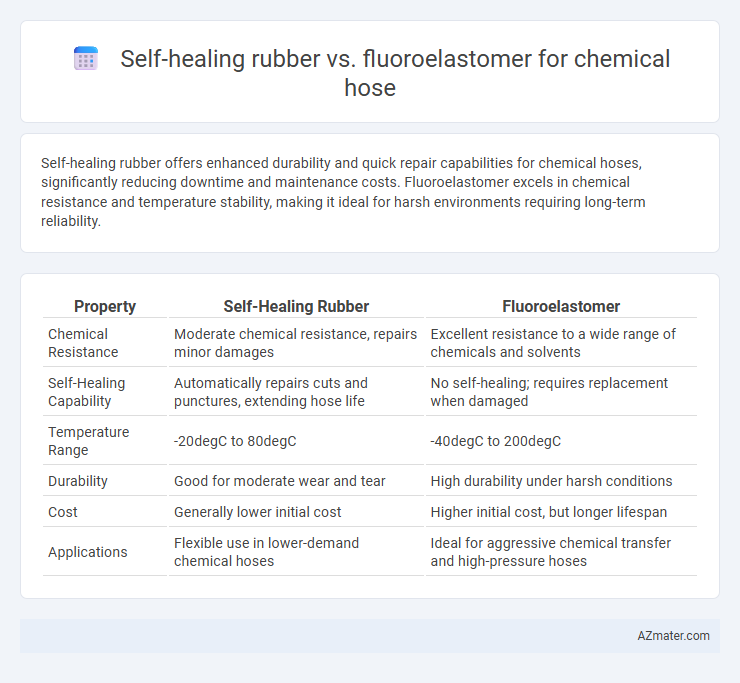Self-healing rubber offers enhanced durability and quick repair capabilities for chemical hoses, significantly reducing downtime and maintenance costs. Fluoroelastomer excels in chemical resistance and temperature stability, making it ideal for harsh environments requiring long-term reliability.
Table of Comparison
| Property | Self-Healing Rubber | Fluoroelastomer |
|---|---|---|
| Chemical Resistance | Moderate chemical resistance, repairs minor damages | Excellent resistance to a wide range of chemicals and solvents |
| Self-Healing Capability | Automatically repairs cuts and punctures, extending hose life | No self-healing; requires replacement when damaged |
| Temperature Range | -20degC to 80degC | -40degC to 200degC |
| Durability | Good for moderate wear and tear | High durability under harsh conditions |
| Cost | Generally lower initial cost | Higher initial cost, but longer lifespan |
| Applications | Flexible use in lower-demand chemical hoses | Ideal for aggressive chemical transfer and high-pressure hoses |
Introduction to Chemical Hose Materials
Chemical hose materials vary significantly in performance, with self-healing rubber and fluoroelastomers being prominent options. Self-healing rubber offers remarkable resilience and the ability to repair minor damages autonomously, enhancing hose longevity in harsh chemical environments. Fluoroelastomers provide exceptional chemical resistance and temperature stability, making them ideal for handling aggressive fluids and extreme conditions.
Overview of Self-Healing Rubber
Self-healing rubber in chemical hoses offers advanced resilience by autonomously repairing punctures and cuts, enhancing durability and reducing downtime. This material utilizes microcapsules or dynamic covalent bonds to restore the polymer matrix, maintaining hose integrity under harsh chemical exposure. Compared to fluoroelastomers, self-healing rubber provides cost-effective, real-time damage recovery while fluoroelastomers excel in high-temperature and corrosive chemical resistance.
Properties of Fluoroelastomer
Fluoroelastomer chemical hoses offer exceptional chemical resistance, withstanding aggressive fuels, oils, and solvents at temperatures ranging from -20degC to 200degC, making them ideal for harsh industrial environments. Their superior thermal stability and resistance to ozone and weathering ensure long service life, minimizing maintenance and downtime. Compared to self-healing rubber, fluoroelastomers provide better mechanical strength, excellent compression set resistance, and enhanced durability in high-pressure applications.
Chemical Resistance Comparison
Fluoroelastomer chemical hoses exhibit superior chemical resistance compared to self-healing rubber, effectively withstanding aggressive solvents, oils, and acids across a wide temperature range. Self-healing rubber offers moderate resistance but is generally susceptible to degradation when exposed to strong hydrocarbons and harsh chemicals over prolonged periods. Choosing fluoroelastomer materials ensures enhanced durability and longevity in demanding chemical hose applications requiring robust chemical compatibility.
Durability and Lifespan
Self-healing rubber exhibits enhanced durability by autonomously repairing micro-damages, significantly extending the lifespan of chemical hoses exposed to physical stress and abrasion. Fluoroelastomers offer exceptional chemical resistance and thermal stability, maintaining integrity in aggressive chemical environments and high-temperature applications, thereby ensuring prolonged service life. Choosing between self-healing rubber and fluoroelastomer depends on the hose's exposure to mechanical wear versus harsh chemical and thermal conditions, directly impacting overall durability and lifespan.
Self-Healing Capabilities and Benefits
Self-healing rubber exhibits superior self-repair abilities by automatically sealing minor cuts and abrasions, reducing downtime and maintenance costs in chemical hose applications. Fluoroelastomers, while highly resistant to chemicals and extreme temperatures, lack intrinsic self-healing properties, leading to more frequent replacements when damaged. Utilizing self-healing rubber enhances hose lifespan and operational efficiency in chemically aggressive environments by minimizing leakage risks and extending service intervals.
Cost Analysis and Economic Impact
Self-healing rubber offers a cost-effective alternative to fluoroelastomer in chemical hoses due to lower raw material and manufacturing expenses, resulting in reduced initial investment. Fluoroelastomers, while more expensive, provide superior chemical resistance and durability, potentially lowering long-term maintenance and replacement costs. Economic impact analysis shows that industries with high chemical exposure may benefit financially from fluoroelastomer hoses despite higher upfront costs, whereas applications with moderate exposure often achieve cost savings with self-healing rubber.
Flexibility and Performance in Harsh Environments
Self-healing rubber exhibits superior flexibility and quick recovery from abrasions, making it ideal for dynamic chemical hose applications requiring constant movement without compromising durability. Fluoroelastomers offer exceptional chemical resistance and thermal stability up to 200degC, performing reliably in highly corrosive and high-temperature environments but with less elasticity compared to self-healing rubbers. Balancing flexibility and performance under harsh conditions depends on the specific chemical exposure and mechanical demands, with self-healing rubber suited for flexible, repetitive use and fluoroelastomers preferred for extreme chemical resistance and temperature endurance.
Safety and Environmental Considerations
Self-healing rubber in chemical hoses offers enhanced safety by autonomously sealing minor damages, reducing leakage risks and exposure to hazardous chemicals. Fluoroelastomers provide exceptional chemical resistance and durability, minimizing hose replacement frequency and environmental waste from disposables. Both materials improve operational safety, but fluoroelastomers excel in harsh chemical environments, while self-healing rubber supports sustainability through extended hose life and decreased chemical spill incidents.
Choosing the Right Material for Chemical Hoses
Self-healing rubber offers excellent resilience and the ability to repair minor abrasions, making it ideal for chemical hoses exposed to mechanical stress and moderate chemical exposure. Fluoroelastomer excels in extreme chemical resistance and high-temperature stability, suitable for handling aggressive solvents and acids in industrial applications. Selecting between self-healing rubber and fluoroelastomer depends on the hose's chemical compatibility, operating temperature, and mechanical durability requirements.

Infographic: Self-healing rubber vs Fluoroelastomer for Chemical hose
 azmater.com
azmater.com